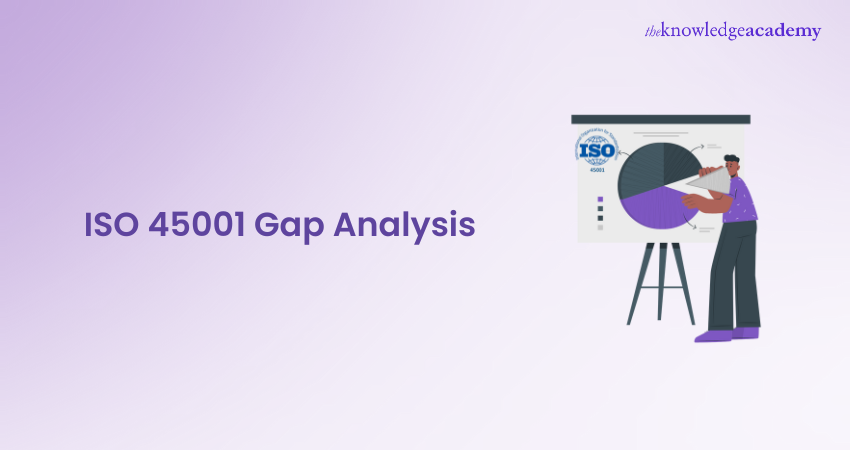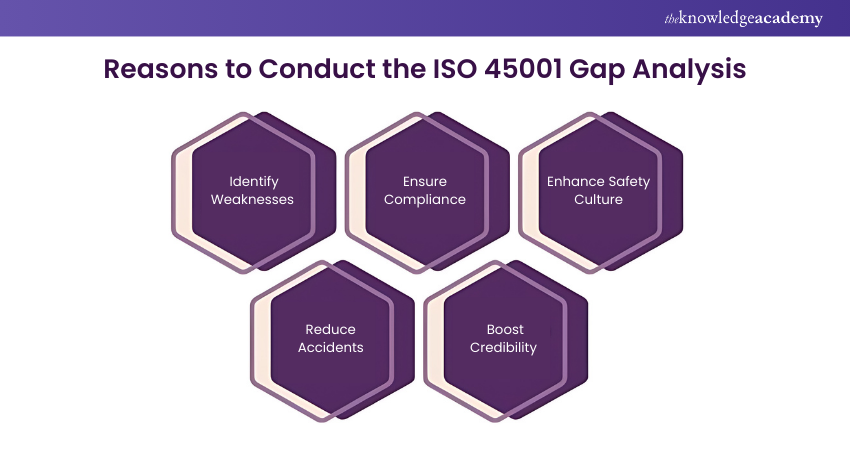We may not have the course you’re looking for. If you enquire or give us a call on +34 932716793 and speak to our training experts, we may still be able to help with your training requirements.
Training Outcomes Within Your Budget!
We ensure quality, budget-alignment, and timely delivery by our expert instructors.

Picture this: your organisation is striving to create a safer workplace, but you’re unsure if your current safety measures are truly effective. This is where an ISO 45001 Gap Analysis becomes invaluable. With its assistance, you can uncover hidden vulnerabilities and ensure your Occupational Health and Safety Management System aligns with international standards.
This comprehensive blog will take you through the process, providing insights and strategies to enhance your organisation’s safety culture and operational efficiency. Let’s explore how an ISO 45001 Gap Analysis can transform your approach to workplace safety.
Table of Contents
1) What is ISO 45001 Gap Analysis?
2) Why Perform ISO 45001 Gap Analysis?
3) Process of Conducting ISO 45001 Gap Analysis
a) Understand the ISO 45001 Standard
b) Identify Current Practices
c) Compare With ISO 45001 Requirements
d) Determine Gaps and Prioritise
e) Develop an Action Plan
f) Implement and Monitor Progress
g) Review and Adjust
4) Conclusion
What is ISO 45001 Gap Analysis?
ISO 45001 Gap Analysis is a tool that helps companies discover discrepancies between their modern health and protection practices, and the necessities of the ISO 45001 standard. It entails scrutinising your safety methods to make certain that they align with industry suggestions.
The ISO 45001 standard serves as the remaining rule book for workplace protection, and the Gap Analysis allows you determine if your practices meet those stringent necessities. During the Gap Analysis, you can examine your present protection measures with the expectations outlined in the standard.
It’s like checking if you have all the necessary pieces to complete the safety puzzle. Any gaps or misalignments identified must be addressed. By conducting an ISO 45001 Gap Analysis, organisations can enhance their safety practices, reduce accidents, and demonstrate their commitment to maintaining a safe work environment. This process ensures that your safety procedures are in line with the highest standards.
Why Perform ISO 45001 Gap Analysis?
ISO 45001 Gap Analysis is essential because it enables firms improve their Health and Safety practices. It lets them compare their current safety strategies with the necessities of the ISO 45001 standards. By doing this Analysis, they can identify areas in which they fall short and want to make enhancements.
The ISO 45001 Gap Analysis helps organisations make certain that they meet the usual expectations, reduce dangers, prevent accidents, and create a safer workplace for all. Gap Analysis is important for some of the reasons noted below:

a) Conducting a Gap Analysis helps organisations ensure that they comply with this standard.
b) The Gap Analysis process helps organisations identify potential gaps and weaknesses in their current Health and Safety practices.
c) ISO 45001 Gap Analysis serves as a catalyst for constant improvement in Health and Safety Management.
d) Conducting a Gap Analysis demonstrates an organisation's commitment to providing a safer and healthy working environment.
e) Gap Analysis provides a benchmark for measuring an organisation's progress towards ISO 45001 compliance.
Learn the importance of Health and Safety Management in an organisation with our ISO 45001 Certification – sign up now!
Process of Conducting ISO 45001 Gap Analysis
The step-by-step process of conducting a Gap Analysis for ISO 45001 is as follows:
a) Understand the ISO 45001 Standard: Familiarise yourself with the requirements and guidelines of the ISO 45001 standard. This will help you determine what to compare your current practices against.
b) Identify Current Practices: Assess your organisation's existing Health and Safety practices, policies, and procedures. Document them and gather relevant information to have a clear understanding of your current state.
c) Compare With ISO 45001 Requirements: Compare your current practices with the specific requirements outlined in the ISO 45001 standard. Identify areas where your practices fall short or differ from the standard's expectations.
d) Determine Gaps and Prioritise: Analyse the gaps between your current practices and the ISO 45001 Requirements. Prioritise these gaps based on their significance and potential impact on safety performance.
e) Develop an Action Plan: Create a detailed action plan to bridge the identified gaps. Define specific tasks, responsibilities, and timelines for implementing necessary improvements. Consider allocating resources and involving relevant stakeholders in the action plan.
f) Implement and Monitor Progress: Put your plan devised on paper into action. Execute the planned improvements and monitor progress closely. Regularly track the implementation to ensure that the necessary changes are being made effectively.
g) Review and Adjust: Continuously review and evaluate the effectiveness of the implemented changes. Make adjustments to your action plan if needed. This iterative process ensures ongoing improvement and alignment with ISO 45001 requirements.
Master the skills needed to effectively audit your organisation’s Safety Management System – join our ISO 45001 Internal Auditor Course now!
Conclusion
In conclusion, conducting an ISO 45001 Gap Analysis is essential for identifying areas of improvement in your organisation’s occupational Health and Safety Management System. By addressing these gaps, you can ensure compliance and enhance workplace safety. Use the insights from your analysis to build a safer, more resilient workplace for everyone.
Master the lead in the field of Safety Management with our ISO 45001 Lead Implementer Course – sign up now!
Frequently Asked Questions

An audit is a formal and comprehensive review that assesses compliance with standards or regulations. In contrast, a Gap Analysis compares current practices to desired outcomes, thereby focusing on finding gaps in performance.

The foremost motive of a Gap Analysis is to pick out overall performance gaps and expand strategies to close them, improving efficiency and assembly goals.

The Knowledge Academy takes global learning to new heights, offering over 30,000 online courses across 490+ locations in 220 countries. This expansive reach ensures accessibility and convenience for learners worldwide.
Alongside our diverse Online Course Catalogue, encompassing 19 major categories, we go the extra mile by providing a plethora of free educational Online Resources like News updates, Blogs, videos, webinars, and interview questions. Tailoring learning experiences further, professionals can maximise value with customisable Course Bundles of TKA.

The Knowledge Academy’s Knowledge Pass, a prepaid voucher, adds another layer of flexibility, allowing course bookings over a 12-month period. Join us on a journey where education knows no bounds.

The Knowledge Academy offers various ISO 45001 Certifications, including ISO 45001 Foundation, ISO 45001 Lead Auditor etc. These courses cater to different skill levels, providing comprehensive insights into various Compliance Framework.
Our ISO & Compliance Blogs covers a range of topics related to the ISO 45001 Foundation, offering valuable resources, best practices, and industry insights. Whether you are a beginner or looking to advance your Compliance skills, The Knowledge Academy's diverse courses and informative blogs have you covered.
Upcoming Health & Safety Resources Batches & Dates
Date
 ISO 45001 Foundation
ISO 45001 Foundation
Mon 10th Feb 2025
Mon 19th May 2025
Mon 8th Sep 2025
Mon 8th Dec 2025







 Top Rated Course
Top Rated Course



 If you wish to make any changes to your course, please
If you wish to make any changes to your course, please


